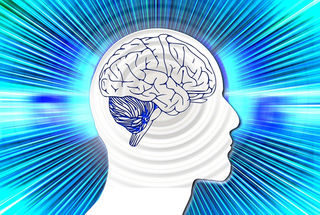Traumatic Brain Injury
AI Brain Device Reduces Need for CT Scans by Over 30 Percent
First FDA-cleared device uses AI to assess full spectrum of brain injuries
Posted May 6, 2019

Traumatic brain injury (TBI) is a disturbance of normal brain functions due to a head injury that everyone is at risk. The Centers for Disease Control and Prevention (CDC) estimates that 138 people die each day in the U.S. due to injuries that include TBI. However, diagnosing TBI often involves unnecessary exposure to radiation from CT (computed tomography) scans. Recently published a few weeks ago in The American Journal of Emergency Medicine, a peer-reviewed publication, physicians at Washington University Barnes Jewish Medical Center in St. Louis found an over 30 percent reduction in unnecessary CT scans for TBI evaluations in emergency rooms using the recently FDA-approved medical device from BrainScope Company, Inc.—a medical neuro-technology company with various public sector and private sector funding, including venture capital from Revolution, founded by Steve Case, the co-founder of America Online (AOL).
Those with moderate to severe TBI are at greater risk for both subsequent additional injuries and death by other causes. The CDC estimates that those with traumatic brain injury are at significantly greater risk to die from seizures (50 times), unintentional drug poisoning (11 times), infections (nine times), and pneumonia (six times), than those without TBI.
Older adults and children are particularly vulnerable to traumatic brain injuries. The CDC estimates that eight out of ten TBIs among older adults was caused by a fall. In children, sports and recreational activities are major causes of TBI.
Annually an average of approximately 283,000 of people under the age of 18 in the U.S. visit emergency rooms due to TBI from sports or recreational activities according to the March 15, 2019 Morbidity and Mortality Weekly Report (MMWR) released by the U.S. Department of Health and Human Services.
The annual average emergency room visits for U.S. children due to nonfatal TBI during 2010-2016 are mostly due to contact sports and playground play per the same report. For U.S. boys, football (52,088), basketball (19,057), bicycling (19,880), playground play (16,095), and baseball (11,888), and hockey (6,697) were the top causes of TBI annual emergency room visits during the report period. The number one cause for girls in the U.S. was soccer (11,670), followed closely by playground play (11,255), then basketball (10,617), gymnastics (7,284), bicycling (6,075), and softball (5,155). The activity with the least amount of TBI for children that resulted in annual emergency room visits, was bowling—113 boys and 47 girls on average each year during the MMWR report period.
Many TBI patients who undergo CT scans are unnecessarily exposed to radiation. According to a study published in the Journal of Head Trauma Rehabilitation in 2016, researchers from Johns Hopkins University School of Medicine, University of Rochester, and the Uniformed Services University of the Health Sciences, discovered that among the study participants who received CT scans for TBI evaluation, only 9 percent had CT evidence of traumatic abnormalities.
Additionally, the American Academy of Pediatrics estimates that 50 percent of children who visit the emergency room with head injuries receive CT scans, but a third of these scans are not medically necessary.
In the study published in The American Journal of Emergency Medicine, physicians evaluated 91 patients, who were all referred for a head CT scan at the emergency room at Barnes-Jewish Hospital Washington University Medical Center. These patients were also given a non-invasive BrainScope EEG-based Structural Injury Classifier (“SIC”) evaluation with a single-use, disposable electrode headset for the duration of five to ten minutes.
According to BrainScope, for those with mild TBI (mTBI), their flagship product BrainScope One is the “first and only FDA-cleared medical device to offer capabilities to assess the full spectrum of brain injury – from concussions (functional abnormality) to brain bleeds (structural injury).”
The brain electrical activity (EEG) of the patients were acquired from the frontal forehead using by BrainScope’s Ahead hand-held device that runs on Android OS with a user-friendly graphical user interface (GUI).
For the next step, non-EEG signals or artifacts were filtered using BrainScope’s algorithms. Using advanced signal processing, the brain activity traits are obtained and quantified to be used as biomarkers for input into algorithms.
According to BrainScope, the “binary discriminant classification functions were derived using methods including genetic algorithms, a form of evolutionary algorithms,” and “the final classifier functions consist of weighted combinations of selected linear and nonlinear features that reflect brain electrical activity which mathematically describes traumatic structural brain injury as distinguished from normal or concussed brain activity.”
The physicians discovered that “integrating BrainScope’s EEG-based objective SIC into the decision-making process for CT referrals would have led to a significant reduction of unnecessary CT scans by approximately 31%” according to the same report. Now the medical community has a non-invasive medical device that uses sophisticated artificial intelligence technology that can reduce exposure to unnecessary radiation for minor traumatic brain injury patients.
Copyright © 2019 Cami Rosso All rights reserved.
References
Centers for Disease Control and Prevention. “Traumatic Brain Injury & Concussion.” Retrieved 5-6-2019 from https://www.cdc.gov/traumaticbraininjury/index.html
ABIM Foundation. “CT scans for children with head injuries.” Retrieved 5-6-2019 from http://www.choosingwisely.org/wp-content/uploads/2018/02/CT-Scans-For-C…
BrainScope (2019 May 6). Over 30% Reduction in Unnecessary Head CT Scans When Integrating FDA-Cleared BrainScope One. [Press Release]. Retrieved https://brainscope.com/media?category=Press%20Release




